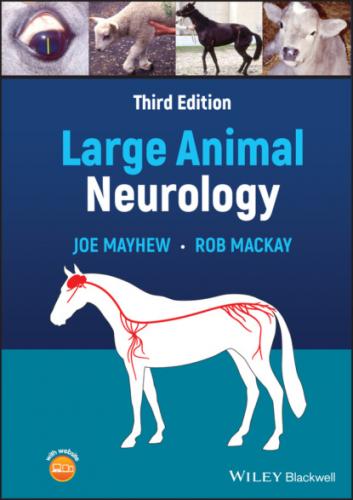References
1 1 Beltran E, Matiasek K and Hartley C. Equine neuroophthalmology. In Equine Ophthalmology, Gilger BC, Editor. 3rd ed. Wiley‐Blackwell, Oxford, UK. 2016; 567.
2 2 Irby NL. Neuro‐ophthalmology in horses. Vet Clin North Am Equine Pract 2011; 27(3): 455–479.
3 3 Mayhew IG. Neuro‐ophthalmology: a review. Equine Vet J Suppl 2010( 37): 80–88.
4 4 Myrna KE. Neuro‐ophthalmology in the Horse. Vet Clin North Am Equine Pract 2017; 33(3): 541–549.
5 5 Lavach JD. Large Animal Ophthalmology. Mosby, St. Louis, MO. 1990; 395.
6 6 Barnett KC, Crispin SM, Lavach JD and Matthews AG. Equine Ophthalmology: An Atlas and Text. 2nd ed. Saunders, Edinburgh. 2004; 274.
7 7 Park JC, Moura AL, Raza AS, et al. Toward a clinical protocol for assessing rod, cone, and melanopsin contributions to the human pupil response. Invest Ophthalmol Vis Sci 2011; 52(9): 6624–6635.
8 8 Yeh CY, Koehl KL, Harman CD, et al. Assessment of rod, cone, and intrinsically photosensitive retinal ganglion cell contributions to the canine chromatic pupillary response. Invest Ophthalmol Vis Sci 2017; 58(1): 65–78.
9 9 Hall CA and Chilcott RP. Eyeing up the future of the pupillary light reflex in neurodiagnostics. Diagnostics (Basel) 2018; 8(1): 19.
10 10 Kim J, Heo J, Ji D and Kim MS. Quantitative assessment of pupillary light reflex in normal and anesthetized dogs: a preliminary study. J Vet Med Sci 2015; 77(4): 475–478.
11 11 Komaromy AM, Abrams KL, Heckenlively JR, et al. Sudden acquired retinal degeneration syndrome (SARDS): a review and proposed strategies toward a better understanding of pathogenesis, early diagnosis, and therapy. Vet Ophthalmol 2016; 19(4): 319–331.
12 12 Gregoline B. Eponyms. Chapter 15 in AMA Manual of Style: A Guide for Authors and Editors. 11th edition. Oxford University Press. 2020.
13 13 Musk GC, King M and He BL. Horner syndrome in 2 pigs (Sus scrofa) after vascular grafting of the carotid artery and jugular vein. Comp Med 2017; 67(6): 518–523.
14 14 Samimi AS, Shafiian A, Rezaei M, et al. Horner's syndrome and unilateral facial paresis in a goat: a case report. Comp Clin Pathol 2016; 25(2): 469–472.
15 15 Ding P, Tufano R, Campbell‐Malone R, et al. Horner syndrome after carotid sheath surgery in a pig: anatomic study of cervical sympathetic chain. Comp med 2011; 61: 453–456.
16 16 Borges AS and Watanabe MJ. Guttural pouch diseases causing neurologic dysfunction in the horse. Vet Clin North Am Equine Pract 2011; 27(3): 545–572.
17 17 Simoens P, Lauwers H, De Muelenare C, Muylle E and Steenhaut M. Horner's syndrome in the horse: a clinical, experimental and morphological study. Equine Vet J Suppl 1990( 10): 62–65.
18 18 Mayhew IG. Horner's syndrome and lesions involving the sympathetic nervous system. Equine Pract 1980; 2(5): 44–47.
19 19 Smith JS and Mayhew IG. Horner's syndrome in large animals. Cornell Vet 1977; 67: 529–542.
20 20 Purohit RC, McCoy MD and Bergfeld WA, III. Thermographic diagnosis of Horner's syndrome in the horse. Am J Vet Res 1980; 41(8): 1180–1182.
21 21 Palumbo MIP, Moreira JJ, Olivo G, et al. Right‐sided laryngeal hemiplegia and Horner's syndrome in a horse. Equine Vet Educ 2011; 23(9): 448–452.
22 22 Jenkinson DM, Elder HY and Bovell DL. Equine sweating and anhidrosis Part 1: equine sweating. Vet Dermatol 2006; 17(6): 361–392.
23 23 Jenkinson DM, Elder HY and Bovell DL. Equine sweating and anhidrosis Part 2: anhidrosis. Vet Dermatol 2007; 18(1): 2–11.
24 24 Pace LW, Wallace L, Rosenfeld CS and Sansone J. Intracranial squamous cell carcinoma causing Horner's syndrome in a cow. J Vet Diagn Invest 1997; 9(1): 106–108.
25 25 Tawfeeq MM, Miura S, Sugimoto K, et al. Thymic lymphosarcoma with brain involvement in a Holstein heifer. J Vet Med Sci 2012; 74(11): 1501–1504.
26 26 Guard CL, Rebhun WC and Perdrizet JA. Cranial tumors in aged cattle causing Horner's syndrome and exophthalmos. Cornell Vet 1984; 74(4): 361–365.
27 27 Samuel JL, Kelly WR and Vanselow BA. Intracranial invasion by bovine ocular squamous cell carcinoma via cranial nerves. Vet Rec 1987; 121(18): 424–425.
28 28 Pirie RS, Jago RC and Hudson NP. Equine grass sickness. Equine Vet J 2014; 46(5): 545–553.
29 29 McGorum BC and Pirie RS. Equine Dysautonomia. Vet Clin North Am Equine Pract 2018; 34(1): 113–125.
30 30 Hahn CN and Mayhew IG. Studies on the experimental induction of ptosis in horses. Vet J 2000; 160(3): 220–224.
31 31 Hahn CN and Mayhew IG. Phenylephrine eyedrops as a diagnostic test in equine grass sickness. Vet Rec 2000; 147(21): 603–606.
11 Strabismus
Strabismus refers to abnormal deviation of the central axis of the eyeball. Loss of function of the extraocular muscles innervated by the oculomotor nerve should result in a lateral and slightly ventral strabismus. A medial strabismus should result with abducent nerve lesions. Finally, rotation of the globe such that the medial aspect of the pupil moves dorsomedial should result with trochlear nerve involvement. In each case, the eyeball cannot be moved out of the deviated position by movement and manipulations of the head and thus can be described as fixed strabismus (Figure 11.1). These are rarely seen alone as acquired syndromes in large animals. Both bilateral medial (convergent) strabismus, or esotropia, with exophthalmos (Figure 11.2), and lateral (divergent) strabismus, or exotropia, occur in cattle and are believed to be due to genetic brainstem nuclear defects.1–9 An eyeball deviation, particularly when it stays in a ventral or dorsal position but can be made to move from that abnormal position with head movements, is seen frequently. Usually, this is due to lesions involving the vestibular system and is referred to as vestibular strabismus (Figures 11.3 and 11.4).10–12 This may not be very evident with the head in a normal posture but usually is exaggerated when the muzzle is raised. Also, performing a fundic examination to focus on the position of the optic disc can assist in defining asymmetric positioning of the pair of eyeballs.
Figure 11.1 Although rarely encountered alone in large animals,
